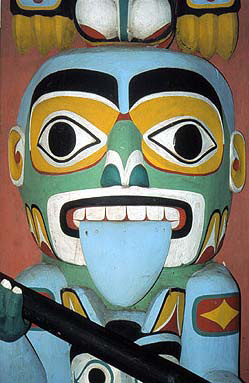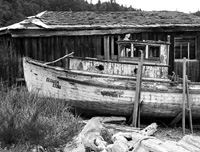The History of British Columbia
 The modern history of British Columbia begins with the First Nations people who have lived and flourished on the lush natural resources of these lands for over ten thousand years, since some time after the end of the last Ice Age. The modern history of British Columbia begins with the First Nations people who have lived and flourished on the lush natural resources of these lands for over ten thousand years, since some time after the end of the last Ice Age.
There are three prominent First Nations groups of the Pacific Northwest who have divided the land between themselves for thousands of years: the Nootka, the Coast Salish, and the Kwak'wala Speaking Peoples. The rich land and marine resources enabled them to develop complex societies and the intricate aboriginal art forms that are now internationally acclaimed. To the east, in the region now known as the British Columbia Rockies, the Kootenay were the original keepers of the land, having fought fiercely for possession of the precious hot springs found in these mountains. The Carrier nation roamed the interior valleys, the Tsimshians ranged the northern coast, and the Tlingits occupied southern Alaska and northern British Columbia. The Sekani and Beaver occupied the eastern region of the north while the Haida lived on the Queen Charlotte Islands.
As recently as 220 years ago the northwest coast of North America was one of the least explored areas in the world. The geography of the land presented many formidable natural barriers to European explorers. To the east the soaring Rocky Mountains blocked the way, and the huge Pacific Ocean separated distant land masses off the west coast. The desire to explore and discover new land and natural resources prevailed in the second half of the 18th century, with expeditions mounted by the Russians, American, Spanish and British explorers and traders.

The peaceful existence of the aboriginal people was to change soon after the first contact by Europeans in 1778, when Captain James Cook set foot on Nootka Island on the northwest coast of Vancouver Island. The Spanish later arrived and set up a base at Nootka under the command of Don Juan Fransisco de la Bodega y Quadra, who had claimed the coast of Alaska for Spain. In 1792, Captain George Vancouver, with his ships Discovery and Chatham, arrived at Nootka Sound to take regain control under the terms of the Nootka Convention.
Both explorers made the trip to Tahsis to resolve years of Spanish/English rivalry that had played out on this Island, and commenced working together at the task of mapping and exploring the coast. A Treaty in 1793 gave the two countries joint ownership of Nootka, but it was not long after the signing that Spain's dominance in North America began to wane. The last Spanish ship was ordered out of the area in 1795, marking the end of the Spanish influence In British Columbia.
Southwestern British Columbia's history centres around the discovery of the mighty Fraser River. Ironically, the early European explorers roaming the coast missed the mouth of the Fraser River due to the dense fog. The Fraser was discovered in 1791 by Spaniard Jose Maria Narvaez, a pilot in the Spanish Navy.
Adventurous explorers and fur traders of the Northwest Company were heading west across the Rockies. Michael Phillips was the first white man to blaze a trail across the Canadian Rockies from west to east through an unexplored pass, although routes were long known by the First Nations people.
The Peace River, the only British Columbia River that drains into the Arctic Ocean, was navigated by explorer Alexander Mackenzie in 1793. Mackenzie was the first European to navigate the Peace River, which was named for a treaty between the Cree and Beaver First nations in 1790. In the Dean Channel near Bella Coola on the west coast, you can still see the rock where he inscribed Alexander Mackenzie from Canada by land 22nd July 1793.
In 1794 the first white settlement in British Columbia was established at what is now Fort St, John. In 1805, the Hudson's Bay Company (HBC) opened their first trading post in the region at Hudson's Hope in the north. In 1808, when Simon Fraser visited the communities along the mouth of the Fraser River, he thought he had found the Columbia River. After Simon Fraser came the equally famous explorer David Thompson, who followed the Columbia River through British Columbia, into Washington and on to its mouth at Astoria, Oregon. The names of these two explorers are indelibly printed in the history of British Columbia, adorning hotels, rivers and street signs. The two major fur trading companies, the Hudson's Bay Company and the North West Company amalgamated under the HBC in 1821.
The Hudson's Bay Company built Fort Victoria in 1843, and the colony of Vancouver Island was established in 1849 when the entire island was leased to the HBC. In 1858, over 20,000 determined prospectors (many from California, where the gold rush of 1849 had petered out) came from the HBC stockade of Fort Victoria and up the Fraser River in search of recently discovered gold on the Fraser River. Soon, instant towns sprang up and grew to become flourishing boomtowns. The legacy of these prospectors can be found in the many Ghost Towns that dot the Interior today.
In response to the frenzied discovery and mining of gold, the British Government quickly created the mainland colony of British Columbia in 1858. Governor James Douglas, chief factor of the Hudson's Bay Company and governor of Vancouver Island, became the new governor of British Columbia. In 1866 the colony of Vancouver Island was combined with the colony of British Columbia, with Victoria becoming the provincial capital of British Columbia on April 2 1868. In 1871, with the promise of completing the Canadian Pacific Railway by 1885, British Columbia was lead into confederation, rather than join the United States to the south, with Victoria as the seat of Government.
Gold discoveries continued, with gold being found in the Peace River in 1861. The Cariboo Wagon Road was constructed from the town of Yale to the boomtown of Barkerville, which in in its heyday was the largest city west of Chicago and north of San Fransisco. Completed in 1865, the Cariboo Wagon Road opened up the British Columbia Interior, with mule trains and stagecoaches plying the route, and roadhouses and boomtowns dotting the roadside. Gold was discovered further north, placing Dawson Creek on the brink of the huge Klondike Gold Rush of 1898.
The mining industry, the railway, and the geology of the land have all contributed to the history and development of British Columbia. The rise and fall of many settlements can be attributed to the route of the railway, while natural features, such as the abundance of hot springs in the BC Rockies, have been responsible for the eventual growth of resort towns.
 The fur and salmon trade brought great prosperity to the First Nations people, whose society was organized around wealth, possessions and potlatches. The HBC generally treated the natives fairly, and their communities thrived. However, the commerce caused the indigenous people to abandon their traditional homesites in favour of settlements closer to the forts for improved trading and protection. The settlers introduced muskets, alcohol and smallpox, all of which had a devastating effect on the native people. Christian missionaries arrived and set about banning the natives' traditional potlatches and suppressing their languages and culture. Colonization and land ownership conflicts soon followed, continuing to this day. The fur and salmon trade brought great prosperity to the First Nations people, whose society was organized around wealth, possessions and potlatches. The HBC generally treated the natives fairly, and their communities thrived. However, the commerce caused the indigenous people to abandon their traditional homesites in favour of settlements closer to the forts for improved trading and protection. The settlers introduced muskets, alcohol and smallpox, all of which had a devastating effect on the native people. Christian missionaries arrived and set about banning the natives' traditional potlatches and suppressing their languages and culture. Colonization and land ownership conflicts soon followed, continuing to this day.
We would like to thank www.britishcolumbia.com and www.vancouverisland.com for giving us permission to use the above information . Any reproduction in whole or in part without authorization is strictly prohibited.
|


